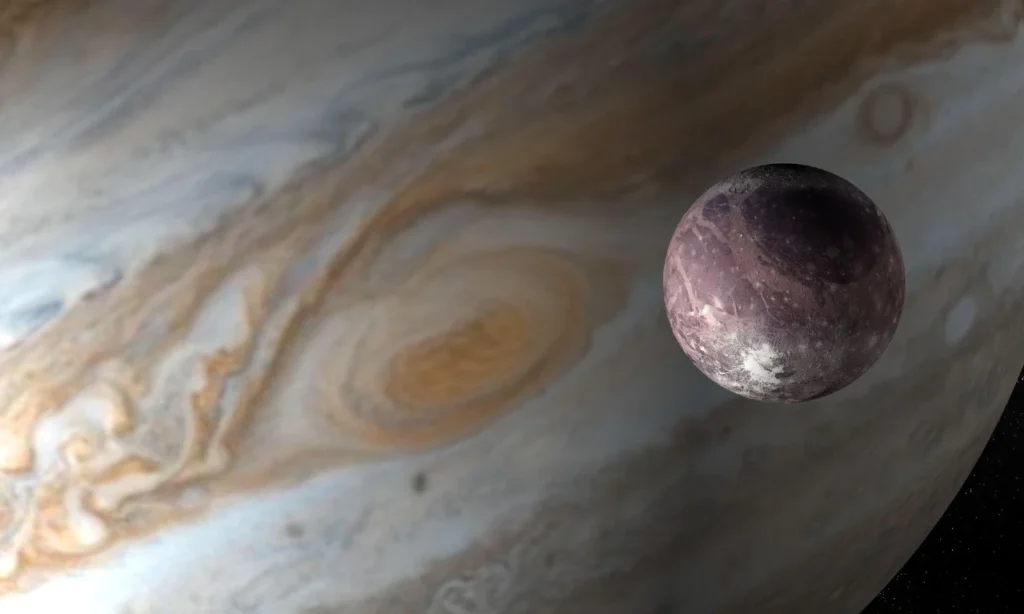Research indicates that Ganymede, the largest moon in the solar system, was struck by an ancient asteroid 20 times larger than the one that ended the dinosaurs’ reign on Earth 66 million years ago. This significant impact event took place 4 billion years ago, causing Ganymede, one of nearly 100 moons orbiting Jupiter, to rotate in a way that positioned the impact crater almost directly opposite the gas giant. The asteroid that hit Ganymede, measuring approximately 185 miles across, created an impact that has left lasting marks on the moon’s surface and possibly its interior.
The Asteroid’s Impact on Ganymede’s Rotation
According to computer models, the asteroid that struck Ganymede did so at an angle of 60 to 90 degrees. This collision created an initial crater up to 1,000 miles wide, which was partially filled with rock and dust ejected from the impact site. Dr. Naoyuki Hirata, a planetary scientist at Kobe University in Japan, has studied the distinctive furrows on Ganymede’s surface, which have long been considered remnants of multiple concentric rings formed by the asteroid impact. However, until now, the scale of the impact and its effect on the moon were not clearly understood.
Hirata’s research, published in Scientific Reports, highlights how the center of these furrows points almost directly away from Jupiter. This alignment suggests that the asteroid’s impact added extra mass to the impact zone, destabilizing Ganymede and causing it to rotate on its axis. The computer simulations conducted by Hirata support the theory that the asteroid’s impact could have caused Ganymede to swivel, making the impact site always face away from Jupiter. Like Earth’s moon, Ganymede is tidally locked to its planet, meaning it consistently shows the same face to Jupiter.
The Devastating Consequences for Ganymede
The impact of an asteroid 20 times bigger than the dinosaur-killer would have had dramatic consequences for Ganymede, which is larger than Mercury, with a diameter exceeding 3,000 miles. The collision likely “completely removed the original surface,” according to Hirata, and may have also affected the moon’s interior, which scientists believe contains a hidden saltwater ocean. This catastrophic event, which occurred billions of years ago, reshaped Ganymede’s surface and potentially altered its internal structure in ways that continue to intrigue scientists today.
Although alternative explanations for Ganymede’s surface features cannot be entirely ruled out, the evidence presented by Hirata strengthens the theory that a massive asteroid impact played a significant role in shaping the moon. The European Space Agency’s Juice probe, which was launched last year, may provide further evidence to support or challenge this hypothesis. The Juice mission is designed to explore Jupiter and its moons, searching for pockets of water and sources of energy that are essential for life on these celestial bodies.
Exploring Ganymede’s Surface and Interior
Professor Leigh Fletcher, a planetary scientist at the University of Leicester, emphasizes that the ancient terrains on Jupiter’s moons, including Ganymede, bear witness to billions of years of bombardment, much of which remains visible today. “Understanding the overlapping events on these satellite surfaces is challenging,” Fletcher said. “This research is a clever use of computer simulations to explore the distribution of scars across Ganymede.”
The Juice mission is particularly well-equipped to study Ganymede further. According to Fletcher, “Not only will it capture the best images ever obtained of the surface fractures, but it may also reveal remnants of the impact and reorientation in Ganymede’s shape or gravity field, thanks to Juice’s advanced instruments.” The observations from the Juice mission are expected to provide valuable new insights into the “impact and reorientation” hypothesis, potentially confirming or refuting the idea that an asteroid 20 times bigger than the dinosaur-killer was responsible for the dramatic changes observed on Ganymede.
The Importance of Understanding Ganymede’s History
The research on Ganymede’s ancient impact highlights the importance of understanding the history of our solar system’s moons. These celestial bodies have experienced billions of years of bombardment and geological activity, leaving behind a complex record of events that scientists are only beginning to decipher. The findings from studies like Hirata’s and the upcoming data from the Juice mission could offer critical insights into the processes that have shaped not only Ganymede but also other moons and planets in the solar system.
In conclusion, the discovery that an asteroid 20 times bigger than the dinosaur-killer hit Jupiter’s moon Ganymede provides a fascinating glimpse into the violent history of the solar system. This catastrophic event, which took place 4 billion years ago, may have caused Ganymede to rotate in a way that permanently altered its surface and interior. As scientists continue to explore Ganymede and other moons, they will uncover more about the forces that have shaped these distant worlds, contributing to our understanding of the solar system’s history and evolution. The research on the asteroid impact that struck Ganymede, 20 times bigger than the dinosaur-killer, will undoubtedly play a crucial role in these ongoing explorations.
“Stay In Touch With Us For More Latest News & Updates. Follow Us On Twitter and Facebook To Stay Aware”




